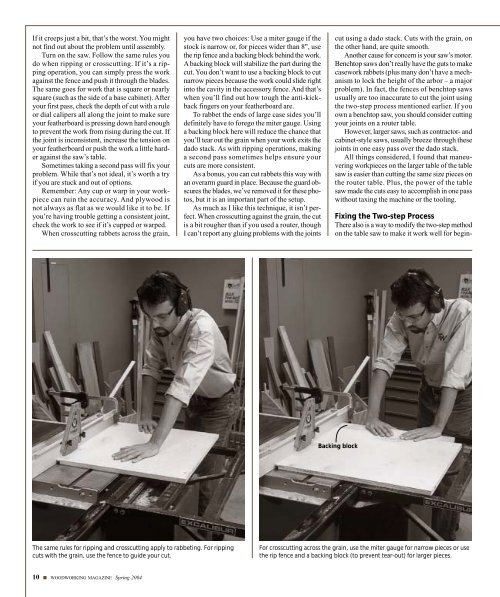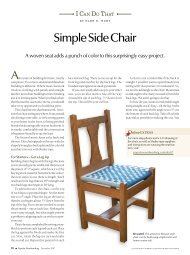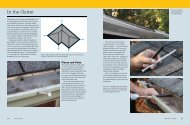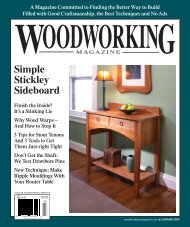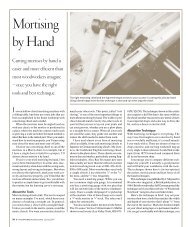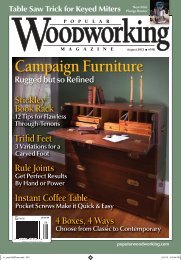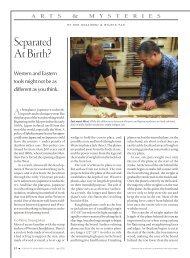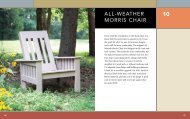Woodworking Magazine, Spring 2004 - Popular Woodworking ...
Woodworking Magazine, Spring 2004 - Popular Woodworking ...
Woodworking Magazine, Spring 2004 - Popular Woodworking ...
Create successful ePaper yourself
Turn your PDF publications into a flip-book with our unique Google optimized e-Paper software.
If it creeps just a bit, that’s the worst. You might<br />
not find out about the problem until assembly.<br />
Turn on the saw. Follow the same rules you<br />
do when ripping or crosscutting. If it’s a ripping<br />
operation, you can simply press the work<br />
against the fence and push it through the blades.<br />
The same goes for work that is square or nearly<br />
square (such as the side of a base cabinet). After<br />
your first pass, check the depth of cut with a rule<br />
or dial calipers all along the joint to make sure<br />
your featherboard is pressing down hard enough<br />
to prevent the work from rising during the cut. If<br />
the joint is inconsistent, increase the tension on<br />
your featherboard or push the work a little harder<br />
against the saw’s table.<br />
Sometimes taking a second pass will fix your<br />
problem. While that’s not ideal, it’s worth a try<br />
if you are stuck and out of options.<br />
Remember: Any cup or warp in your workpiece<br />
can ruin the accuracy. And plywood is<br />
not always as flat as we would like it to be. If<br />
you’re having trouble getting a consistent joint,<br />
check the work to see if it’s cupped or warped.<br />
When crosscutting rabbets across the grain,<br />
you have two choices: Use a miter gauge if the<br />
stock is narrow or, for pieces wider than 8", use<br />
the rip fence and a backing block behind the work.<br />
Abacking block will stabilize the part during the<br />
cut. You don’t want to use a backing block to cut<br />
narrow pieces because the work could slide right<br />
into the cavity in the accessory fence. And that’s<br />
when you’ll find out how tough the anti-kickback<br />
fingers on your featherboard are.<br />
To rabbet the ends of large case sides you’ll<br />
definitely have to forego the miter gauge. Using<br />
a backing block here will reduce the chance that<br />
you’ll tear out the grain when your work exits the<br />
dado stack. As with ripping operations, making<br />
a second pass sometimes helps ensure your<br />
cuts are more consistent.<br />
As a bonus, you can cut rabbets this way with<br />
an overarm guard in place. Because the guard obscures<br />
the blades, we’ve removed it for these photos,<br />
but it is an important part of the setup.<br />
As much as I like this technique, it isn’t perfect.<br />
When crosscutting against the grain, the cut<br />
is a bit rougher than if you used a router, though<br />
I can’t report any gluing problems with the joints<br />
cut using a dado stack. Cuts with the grain, on<br />
the other hand, are quite smooth.<br />
Another cause for concern is your saw’s motor.<br />
Benchtop saws don’t really have the guts to make<br />
casework rabbets (plus many don’t have a mechanism<br />
to lock the height of the arbor – a major<br />
problem). In fact, the fences of benchtop saws<br />
usually are too inaccurate to cut the joint using<br />
the two-step process mentioned earlier. If you<br />
own a benchtop saw, you should consider cutting<br />
your joints on a router table.<br />
However, larger saws, such as contractor- and<br />
cabinet-style saws, usually breeze through these<br />
joints in one easy pass over the dado stack.<br />
All things considered, I found that maneuvering<br />
workpieces on the larger table of the table<br />
saw is easier than cutting the same size pieces on<br />
the router table. Plus, the power of the table<br />
saw made the cuts easy to accomplish in one pass<br />
without taxing the machine or the tooling.<br />
Fixing the Two-step Process<br />
There also is a way to modify the two-step method<br />
on the table saw to make it work well for begin-<br />
Backing block<br />
The same rules for ripping and crosscutting apply to rabbeting. For ripping<br />
cuts with the grain, use the fence to guide your cut.<br />
For crosscutting across the grain, use the miter gauge for narrow pieces or use<br />
the rip fence and a backing block (to prevent tear-out) for larger pieces.<br />
10 ■ WOODWORKING MAGAZINE <strong>Spring</strong> <strong>2004</strong>


